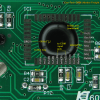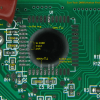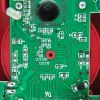If I were stranded on a deserted island trying to fix the radio, I would be happy to have one of these. Otherwise, they’re the subjects of a study in how to make DMMs as cheaply as possible.
Model 92020
Purchased at Harbor Freight for $2.99 on sale. This is the one with the back-light. Of the two samples documented here, this was the better one. Obviously it would not hold up to continuous use, but it did give accurate repeatable readings.
Model 69096
Also purchased at Harbor Freight for $2.99 with a coupon. This one looks a lot like the one above, but without the back-light. The build quality (relatively speaking, of course) was not as good as the back-light model. It gave steady repeatable readings on DC and AC volts, but in resistance and milli-amp modes, it would never give the same reading twice.
Update #1: After re-soldering the input jacks, replacing the solder bridges with some copper braid, and tweaking the calibration pot, the 69096 meter functionality improved to be on par with it’s backlit cousin. I get the feeling it’s ‘luck of the draw’ with these things.
Update #2: Everybody seems to have an opinion about these little red/yellow boxes, but I find myself disagreeing a bit with some of the stuff I read and hear online. So let’s do a little myth-busting.
Myth #1: These 830-style DMMs are not accurate.
Actually, the ICL7106 Analog-to-Digital Converter/LCD Driver clone (under the black blob) is extremely well-suited for rendering very accurate DC voltage measurements. It is quite possible, even probable, that it can easily match a more expensive DMM digit-for-digit on the DC voltage scale, especially if the calibration trimmer is tweaked. (Some of the latest ones do not have a trimmer.) For functions other than DC volts, more variables are involved, so the word “ballpark” becomes operative.
Myth #2: “It matches my buddy’s Fluke, so it’s just as good as the Fluke.”
No, it isn’t. The Fluke is made to be reliable, remain accurate, and last many years and provide measurement confidence. This unit is made from a dollar’s worth of cheap parts and cheap plastic, and it’s a crap shoot as to whether it will remain structurally intact for any length of time. The leads are particularly short-lived.
Myth #3: It will explode and kill you if you use it to measure the mains.
If the meter and leads are in good condition, and you plug the leads in and set the switch correctly, it should measure up to 240 VAC in a standard residence with no drama whatsoever. No explosions. If the leads are plugged into the 10A current jack, or the range switch is set to ohms or current, then you might get sparks, smoke, and startling noises. Unless you’re holding the meter in your mouth, the only fatality is likely to be the meter itself. But please, don’t use this device anywhere near commercial/industrial distribution panels where deadly arc flash incidents are actually possible.
Myth #4: These are good enough for a beginner or an amateur at electronics/electricity.
These things can definitely lie to you. Low ohms measurements are likely to be way off. The AC voltage ranges are DC-coupled and will appear to read non-existent AC voltages in the presence of DC. The unreliable nature of the leads, the rotary switch, etc. can result in inconsistent readings at inconvenient times. This means trouble for users who cannot easily differentiate between a real fault and a failure of the measuring device. Novices do not need a $200 DMM, but they definitely need something reasonably reliable that is less likely to give misleading readings.
Just $20 can get you a tool that is an order of magnitude better than these toys.




Now you gave them a fair rating, they do work but you have to calibrate them.
The ac side is ignored on mine, i know its crude so i dont use it.
They have become very “Tight Arsed” with there pcb and component types.
The mastech M-830B type that i have is the full pcb type that fills the case and no bodged
on terminal pcb lol, the resistors are the typical blue body 0.6watt through pcb types.
For the price you pay they are quite accurate, for the 200 ohms range the switch and
sockets must be very clean to show 0.3 ohms when shorted.
Its not the fault of the 7106 clone, its the cheap switch that causes problems.
I payed £5 ($8) for it and for basic go- no go testing its fine, and if its dropped by accident
then i dont panic like i would with the fluke.:-)
An ICL7106 alone would cost more than that!!
Safety wise, it reads mains voltage ok, 240vac is safe enough with that thickness of
plastic case around it, i would never ever expect the high voltage performance that some unfair testing people demand, the australian man, you know who i mean lol.
The one i have does have the ptc for ohms 🙂 only needed if you are really a plonker lol.
I also have a very old Micronta 22-191 digital 10 million ohms input one from the 1980’s,
it cost me £80 and is no more accurate than the 830b, its a good old meter ive used for
years and would be unhappy when the single SXC 1901F chip dies 🙁 impossible to get 🙁
Im waffling again, sorry lol :-))
For $3, something has to be tight.
Absolutely nothing wrong with the good old ICL7106. Did you catch this thread at EEVblog? The original 8060A designer tells us that Intersil wasn’t exactly authorized to bless the world with that design.
Speaking of crude AC, that reminds me I left out the best picture, which has now been added to the gallery.
Oooow so fluke had a hand in the design of the icl7106 or whatever fluke called it, no wonder it worked so well 🙂
Yes intersil was naughty but we would never of had such a great chip without them, fluke would have kept it to themselves and the multimeter market would be less interesting.
Im sure other manufacturers looked at the 7106 and reworked it into there own versions, i know there are many variations around now 🙂
I like the 7106 as you can get a very good result, ratio metric resistance and dc volts can be great with only 0.5% tolerance ref resistors.
With the addition of a precision ac to dc converter the ac side becomes usable.
I find electronics becoming more boring, all the designs are being based around one massive beasty lsi chip, and its a dam computer again!!, with special programming, you may buy the chip but you wont be able to get the code to make it function, shame, but the 7106 was replaceable 🙂
Ha ha the 830b set on ac but dc was the input, well its a diode and a tapped into the resistor chain, cant expect much, perhaps a capacitor in series would have stopped the effect but it would not have improved the crude ac readings lol.
I too have looked at the schematic of one the the old flukes you have featured and thought “that chip is wired like a 7126” almost, 1 pin different lol.
Thanks for reviewing these meters. I have one of these still new in the package (I think I paid a $1.99) that I am wanting to do some destructive testing on. I would like to make it either burst into flames or explode. (Using only electricity.) If I can get it to do either one I will let you know.
The thread on the EEVblog is fascinating. I would like to see you get your hands on some of the stuff he was taking about.
I’ve heard so much about these little boxes that I just had to put my grubby hands on a couple, out of pure curiosity! I’ll leave it to the individual reader/viewer to decide whether they’re useful or not. But I couldn’t help making a few snarky comments…
I had something like those but it read only dc. It didn’t have an ac function as I got from some solar and water cell test kit. It worked fine and I would like something again like these just as a messing around meter when I don’t feel like getting out something better. And maybe a little destroying time.
You do realize that on picture #23, the cheap little HF meter is set on ac volts and you are testing dc voltage on that battery? Ooops!
I have one of these meters because it was free with a coupon. I only use it to see if voltage is present- pretty well untrustworthy, so I use the Fluke or FP meters for actual working.
Not an oops, but a demonstration of an incorrect indication.
I have a better meter, but I have one of these stashed on each floor of my house for quick-and-dirty. I especially appreciate the battery test mode. When stuff gets flakey, it’s always good to be able to rule batteries in or out.
The test leads are the weakest point. The wires are prone to coming out of the probes, and there is no provision for taking the probe apart and re=soldering. Then you discover that the jacks are shorter than standard so off-the-shelf test leads don’t work well. I wish Harbor Freight offered replacements that were also repairable.
Yes even a cheap set of replacement leads are usually better than what comes with these type meters. I think if you cut the safety shrouds off of the banana plugs, standard leads will fit.
I solved that with some very decent leads from ebay at $.99 a pair with free shipping, straight from China. A few seconds work fixed the banana plugs. I trimmed back a little of the outer sleeve and spread the spring blades so the widest part was closer to the end of the plug. I got a good snug fit.
A fair review, although I wouldn’t be totally confident using on house mains, especially on a breaker panel and the 240 distribution (in North America) for stoves, water heaters, clothes dryers, etc. It’s not so much the meter exploding but the probes/leads I don’t trust. Dealing with low voltage battery powered devices, checking batteries and doing some continuity testing I’ve got no problem with. As to reliability and measurement repeatability, that is probably the deal breaker for me. Wouldn’t be good to be testing house mains wiring to see if it’s still live after flipping the breaker that’s supposed to turn it off at the breaker panel . . . only to discover the meter decided to take a quick break from working as it should. I’ve been zapped before. It’s no fun and I’ve always been very, very lucky. Using one of these on something that doesn’t matter much or that doesn’t have enough kick to hurt you (it’s current that kills), is no problem. I’ve got a Radio Schlock El Cheapo analog in a kitchen drawer for just that, although I do trust it now on 120 VAC house mains since replacing the original leads with trustworthy ones. 🙂
John
Also fair points you bring up. I was reacting to the self-appointed internet safety police who tell people it will “explode” if you use it on mains, which is silly. The same people may not think twice about plugging in a dollar-store night light, scent spray thingie, outlet strip or other questionably-made device.
Know your equipment, know it’s limitations, use live-unknown-live testing when safety is at stake. And really, buy better equipment than these things!
I have the 92020 cen-tech multimeter with backlight and when i went to check a 9 volt battery on the 25ma setting i heard something inside meter blow,i took it apart to look at circuit board on both sides to see if i could find anything burnt or out of place that would give me a clue to what was damaged on the 9volt 25ma scale i have not found anything yet that tells me what is causeing the 9 volt battery setting to not work it just reads 1 on a good 9 volt battery or even a new 1.5 volt battery it reads 1 ,before it was working great ,i would like to repair this myself if i knew what circuit the 9 volt 1.5 volt battery setting is on the circuit board
Mine was free. Sooo for that price it works well. DC measurement – not too bad. Ohms are hit and miss, but usually can check for basic continuity. AC is a whole new world with my free meter. USUALLY it will register voltages ( on a 120 volt line ) around 180 volts, sometimes less but I have yet to see any numbers between 100 and 130. SOMETIMES the values – usually very high, are at least fairly consistent 170 – 185 volts and it is good to know the line is HOT… You really can’t expect a free or $1.99 meter to be your go – to, reliable, accurate tool.
We absolutely love your blog and find most
of your post’s to be just what I’m looking for. Does one
offer guest writers to write content for you personally?
I wouldn’t mind publishing a post or elaborating on some of the subjects
you write regarding here. Again, awesome web log!
I started in Electronics in 1965 worked in radio repair. I always had a Fluke to use it was in a special place in the truck or on the bench so it wouldn’t get damaged . That’s were it stayed. The Cen-Tech went in my tool box I used for everything. If if it got broken just stop by harbor freight and pick up a new one. They are more than adequate for any field or bench work.